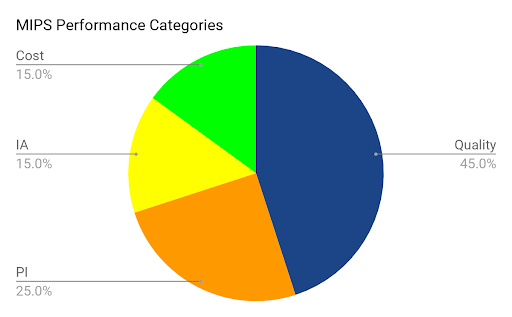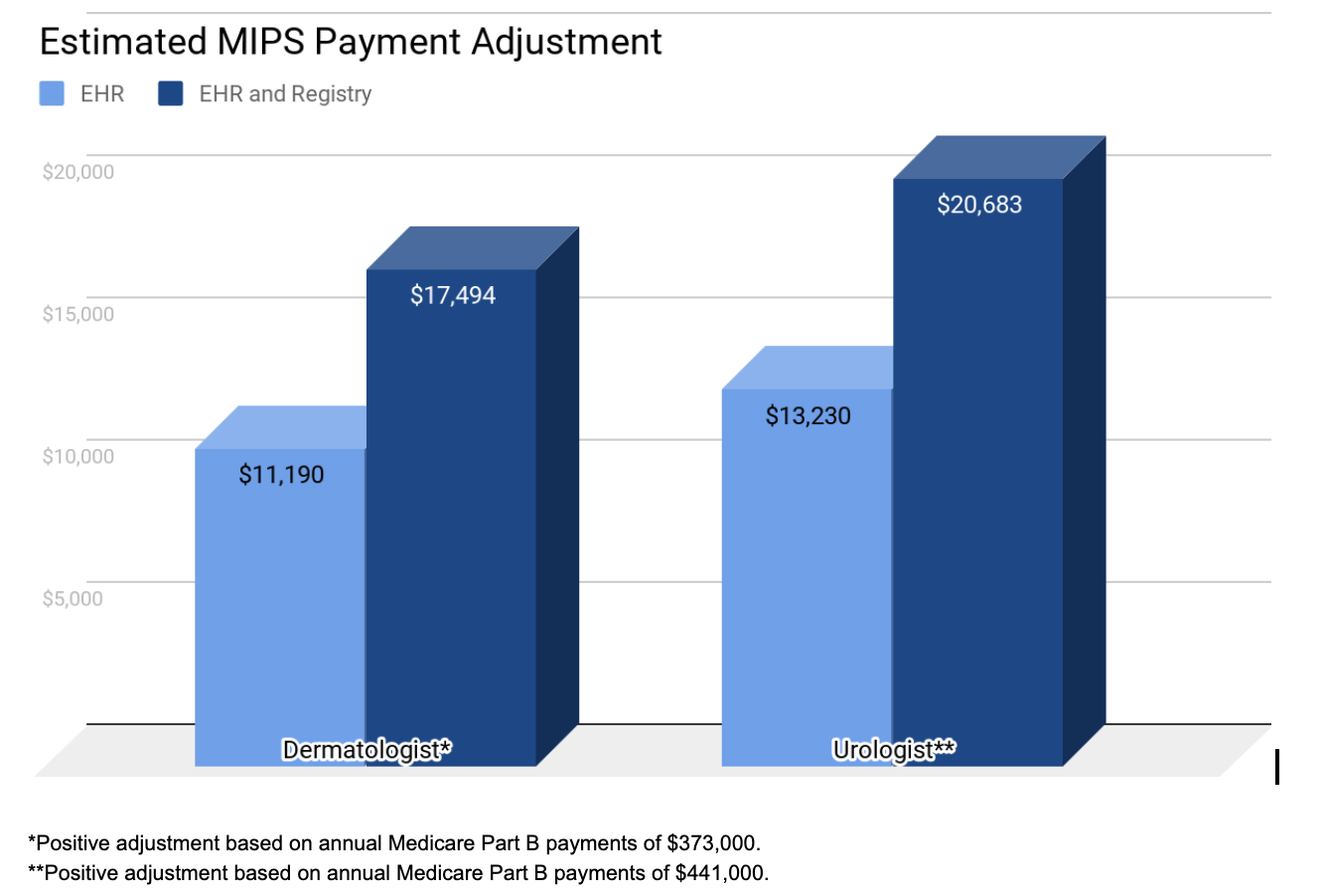
With another MIPS performance year behind us, it is not too early to start thinking about a reporting strategy to ensure MIPS success for 2019. This year CMS is providing new flexibility to report quality measures through multiple submission methods which can help improve MIPS scores and increase incentive payments. In this article we demonstrate how combining registry and EHR measures will help specific clinicians with their MIPS reporting. The strategy would not only boost their MIPS scores, but it would also increase their Medicare payments by thousands of dollars.
Quality Reporting in a Nutshell
The MIPS Quality category is worth 45% of your total MIPS score this year (down from 50% in 2018). Many of the requirements for reporting Quality remain the same. MIPS e ligible clinicians and groups should still report 6 measures, with at least 1 being an Outcome or High Priority measure, or an entire specialty measure set to receive full credit for this category. Each measure should be reported on at least 60% of eligible cases, for both Medicare and non-Medicare payers, for the entire year.
ligible clinicians and groups should still report 6 measures, with at least 1 being an Outcome or High Priority measure, or an entire specialty measure set to receive full credit for this category. Each measure should be reported on at least 60% of eligible cases, for both Medicare and non-Medicare payers, for the entire year.
In 2019, CMS will no longer allow clinicians in large practices (16 or more in the TIN) to report quality measures via claims. However, CMS will permit clinicians and groups of any size to submit measures through more than one reporting method. This added flexibility will help many achieve better outcomes with their MIPS reporting.
Benefits of Combining Registry and EHR Measures
For the 2019 reporting year, CMS is allowing you to report measures collected across multiple collection types, so you no longer have to report all 6 Quality measures through just one mechanism. This means you could report some measures through your EHR (eCQMs) and other measures through a Qualified Registry (CQMs) like MDinteractive, and the measures will all be scored together. This approach offers several important advantages to clinicians.
The Highest Score Counts
If the same measure is collected via multiple collection types, the one with the highest points will count in the final MIPS score. The only exception is if you choose to report through the CMS Web-Interface, you cannot report through any other mechanism.
More Quality Measure Options
For clinicians who have reported MIPS through their EHR in the past, they can now complement their EHR data with other measures available through a registry that are more relevant to their specialty. There are 232 Quality measures available through a registry like MDinteractive, but just 50 Quality measures that can be reported through an EHR. Providers may struggle to find enough measures that are clinically relevant to their practice when reporting through an EHR, or they may report measures in their EHR for which they aren’t capturing data and have poor performance. This strategy can negatively impact their final MIPS score and payment adjustment, so having the option to report through both a registry and an EHR can lead to better results.
Let’s compare the reporting outcomes of just two specialists, a dermatologist and urologist, when reporting through an EHR versus reporting through both a registry and an EHR:
| Specialty | Dermatologist | Urologist | ||
| Collection Type | EHR | EHR and Qualified Registry | EHR | EHR and Qualified Registry |
| Quality Measures | 130, 226, 317, 374, 110, 111 | 130, 226, 317, 374, 137, 138 | 130, 226, 317, 374, 110, 111 | 130, 226, 317, 374, 48, 50 |
| Quality Score | 34.5 points | 45 points | 34.5 points | 45 points |
| Total MIPS Points* | 90 | 100 | 90 | 100 |
*Reporting all MIPS categories.
If reporting through an EHR, these specialists would have no dermatology or urology specific measures available to report. In this example, they reported measures #110 (Influenza Immunization) and #111 ( Pneumococcal Vaccination Status for Older Adults) to reach the minimum requirement of 6 Quality measures. Since the specialists don’t typically collect data for these measures, they would receive a minimum amount of points for each (3 MIPS points per measure) due to their low performance.
As an alternative, the specialists could report specialty-related measures through a registry that would allow them to obtain a better performance score (a maximum of 10 points per measure). Instead of reporting measures #110 and #111, a dermatologist could report measures #137 (Melanoma: Continuity of Care – Recall System) and #138 (Melanoma: Coordination of Care), while a urologist could report measures #48 (Urinary Incontinence: Assessment of Presence or Absence of Urinary Incontinence in Women Aged 65 Years and Older) and #50 (Urinary Incontinence: Plan of Care for Urinary Incontinence in Women Aged 65 Years and Older). The data from the EHR and the registry would be combined together and result in a higher MIPS score for each of the specialists.
Higher Revenue Potential
In the example of the dermatologist and urologist, using multiple reporting mechanisms would greatly impact their Medicare reimbursement. A total MIPS score of 90 points is estimated to earn a +3% payment adjustment in 2021, whereas a MIPS score of 100 points would earn an estimated +4.69% payment adjustment. By combining the EHR and registry measures, these specialists would significantly increase the amount of financial incentives they would receive for their MIPS reporting:

Even after taking into account the cost of reporting the Quality measures with a registry, these specialty providers would still earn thousands more in financial incentives than they would have by just reporting the EHR measures. Giving clinicians the option to report through multiple reporting mechanisms allows them to report their best performing measures to maximize their MIPS scores and Medicare reimbursement.
Important Takeaways
Now’s a good time to think about your MIPS reporting strategy for 2019. The Quality category continues to account for the largest portion of your total MIPS score, so developing a reporting plan that maximizes your Quality points is important. CMS is now permitting you to report measures through multiple reporting mechanisms, so consider whether this approach could improve your chances for reporting success. Our team of MIPS specialists can provide guidance along the way and ensure you have the support tools you need to achieve the best possible outcomes.
Leave a comment